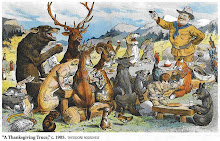ANIMAL WELFARE IN EXTENSIVE PRODUCTION SYSTEMS
https://www.amazon.com/
What are they complaining about???
by: John Laundre
At the risk of sounding like tooting my own horn, I would like to highlight a few aspects of a chapter I wrote on the impact of predation on livestock. This chapter came out in a book titled " Animal Welfare in Extensive Production Systems"(you can purchase by clicking on the link above--available on Amazon-- (Animal Welfare). In this chapter I analyzed the data, the real numbers, not the emotions, of just how much of an impact predators have on livestock.
Harsh weather is a key killer of Cattle
Harsh weather is a key killer of Cattle
As we all know, one of the driving forces behind the wanton killing of predators is that they supposedly are "massacring" our domestic livestock. Literally, taking food out of our mouths. In this chapter I was asked to provide an objective analysis of just how severe this problem is.
Clostridial Disease is a significant killer of Cattle
Are predators really that much of a threat to our livestock, in this case those grown out on the landscape or "extensive" production systems. This is opposed to "intensive" ones where livestock are grown under more controlled, e.g. penned conditions. Not surprisingly, most of these animals grown in extensive systems are primarily in the 11 most western states of our country.
Clostridial Disease is a significant killer of Cattle
Are predators really that much of a threat to our livestock, in this case those grown out on the landscape or "extensive" production systems. This is opposed to "intensive" ones where livestock are grown under more controlled, e.g. penned conditions. Not surprisingly, most of these animals grown in extensive systems are primarily in the 11 most western states of our country.
To do this I looked at the extensive data the USDA keeps on livestock, including losses for various reasons. I specifically looked at cattle and sheep, the two main animals most people are concerned about relative to predators. Here, for sake of space, I will present only data on cattle.
What did I find?
First of all, we do raise an impressive number of cattle (almost 10 million head) and sheep (almost 3 million) out in the wild and thus susceptible to predation by primarily pumas, coyotes, and now in many areas, wolves. Second, regarding cattle, losses to predation in these 11 states amounted to ONLY 0.5%, yes less than 1% of the total number of animals exposed to predation! On the other hand, losses of cattle for a variety of other reasons represented 7.6% of the total number of animals raised. So ranchers are losing up to 15 times as many animals for reasons OTHER than predation!
Wolves are an infrequent killer of Cattle
Economically, predation losses represented only 0.3% of the total value of all cattle grown in extensive systems. Again, non-predatory losses were at 6.3% (21 times higher!). Ranchers are losing more cattle and money from a variety of PREVENTABLE causes than from predators! These causes range from accidents to cattle rustling!
Wolves are an infrequent killer of Cattle
Economically, predation losses represented only 0.3% of the total value of all cattle grown in extensive systems. Again, non-predatory losses were at 6.3% (21 times higher!). Ranchers are losing more cattle and money from a variety of PREVENTABLE causes than from predators! These causes range from accidents to cattle rustling!
How about specific predators? Wolves represented only 0.1% of the total number of animals raised. Pumas and coyotes were even lower at 0.02% and 0.01%. Again, predation is just NOT a very big problem, especially relative to other physical and economic losses ranchers face! Yet ranchers seem to spend a lot of time complaining about it. I liken it to the little boy with his finger in the dike as the dike to his side is breaking apart. If ranchers out west are in economic hard times, it is NOT because of predators!
Coyotes are a minor killer of Cattle
Coyotes are a minor killer of Cattle
The rest of the chapter looks at the numbers for sheep as well as addresses the fact that predation losses, like the rest, are not distributed evenly across ranches. Some ranchers experience even less predation impact while others more than the average.
I also look at predation on a global scale and again, the U.S. is not unique; predation losses worldwide are just not that high. Not high enough for sure to justify the mass elimination of predators from the landscape.
I also look at predation on a global scale and again, the U.S. is not unique; predation losses worldwide are just not that high. Not high enough for sure to justify the mass elimination of predators from the landscape.
I also address way in which even the low losses from predators can even be further reduced, e.g. use of guard dogs. Overall, I hope that this objective analysis of a very emotional subject leads to, as I end by saying "insights not into how we win the war against predators but into developing a truce that we and the native predators can both live with".
Great Pyrenees guard dog of cattle
Great Pyrenees guard dog of cattle
John Laundré
https://www.google.com/url?sa=t&rct=j&q=&esrc=s&source=web&cd=6&cad=rja&uact=8&ved=0ahUKEwjF7-Hi8vnQAhXLslQKHR2oAogQFgg-MAU&url=http%3A%2F%2Fonlinelibrary.wiley.com%2Fdoi%2F10.1890%2F13-1083.1%2Fabstract&usg=AFQjCNHwMxLjJA8xAX_hOmXC3222uDj8OQ&sig2=HWW_RsNKHNvfe_XjMsMoJg
https://www.google.com/url?sa=t&rct=j&q=&esrc=s&source=web&cd=6&cad=rja&uact=8&ved=0ahUKEwjF7-Hi8vnQAhXLslQKHR2oAogQFgg-MAU&url=http%3A%2F%2Fonlinelibrary.wiley.com%2Fdoi%2F10.1890%2F13-1083.1%2Fabstract&usg=AFQjCNHwMxLjJA8xAX_hOmXC3222uDj8OQ&sig2=HWW_RsNKHNvfe_XjMsMoJg














No comments:
Post a Comment